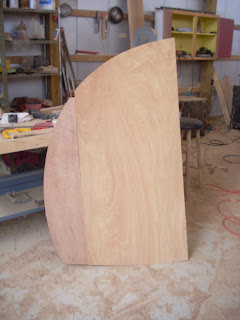The Transom
The transom is one of the most important pieces of a boat. Traditionally it is the weakest part and generally targeted during naval battles (this goes back to the very first naval battles that used rams as the armament and continued through the development of the cannon, on the other hand it probably didn't matter where a modern torpedo hit you). A failure in the transom has caused many a boat to go down. the transom keeps the boat true. The inherent sharp transition at the keel at the lack of timbers created the weakness. The canoe removed this weakness by making the boat have essentially two bows front and back. This design was utilized in large vessels as well as the common river variety that we are familiar. In fact, you see many modern sailboats with this double ended design today. Modern boat building techniques have largely reduced the liability of the transom to negligible levels. Nevertheless, I wanted to take particular care in constructing this part of the boat. I'm not actually sure that I took extra care in its construction because I've been taking pretty damn extra care in the construction of the entire vessel but I will say that I was extra aware during this phase especially with all the difficulty this part caused me. There are no patterns for the transom in the blue prints for this boat. The plans call for taking the shape of the transom from the actual work after a few longitudinal battens are installed. Really! I'm looking at the stern of the boat and seeing the longitudinal battens forming nothing resembling the transom. The port side of the boat in no way resembles the starboard side. The reason is that no two pieces of wood will bend around the hull the same. They all have slightly different internal tensions and, even though they might all start out straight, once you start bending them they will act different. Here is where I deviate from the written instructions of the plans (this won't happen very often). I decided to take the shape of the transom directly from the table of offsets. Of course only the projection onto the flat sheet is provided by the offset tables but I'm pretty good at projections and undoing them. Fifteen years working with sheet metal and creating finials and other decorative items out of flat stock well prepared me for this task. The table of offsets show a beautiful wineglass shaped transom. I spent some time transferring the lines to a pattern and voila' I had the transom shape I wanted.
I butt glued some plywood together and cut the first layer of the transom out (I had to include a little extra material around the edges because these edges would later be beveled to the shape of the hull). The next and much more difficult part was placing the transom at the right angle and orientation at the rear of the boat. For this, I built a jig (I'm a big fan of jigs). Okay, so now the transom is on the jig and in position. I have longitudinal battens rough cut to length on both sides. I still have to install the frame on the transom (the transom frame will be a double lamination of 5/4" oak 6" wide). I still do not know how to install the frames and notch them for the longitudinal battens without cutting into the transom itself (which according to the plans is a no no). I decide to install a few longitudinal battens on the transom. This is very rewarding because now I'm starting to see how the wine glass transom completes the beautiful lines of this boat. After 3 or 4 longitudinal battens are installed on each side of the boat I decide it's time to tackle the frames.
I butt glued some plywood together and cut the first layer of the transom out (I had to include a little extra material around the edges because these edges would later be beveled to the shape of the hull). The next and much more difficult part was placing the transom at the right angle and orientation at the rear of the boat. For this, I built a jig (I'm a big fan of jigs). Okay, so now the transom is on the jig and in position. I have longitudinal battens rough cut to length on both sides. I still have to install the frame on the transom (the transom frame will be a double lamination of 5/4" oak 6" wide). I still do not know how to install the frames and notch them for the longitudinal battens without cutting into the transom itself (which according to the plans is a no no). I decide to install a few longitudinal battens on the transom. This is very rewarding because now I'm starting to see how the wine glass transom completes the beautiful lines of this boat. After 3 or 4 longitudinal battens are installed on each side of the boat I decide it's time to tackle the frames.
 |
| This image shows the frame transitioning form the inside to the outside of the battens. |
 |
| After the dead wood is filled in between the battens. A few more battens have been installed in this photo. The hull shape is starting to look sweet. |




No comments:
Post a Comment
Your feedback is very much appreciated.